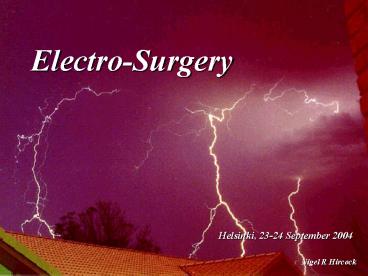Electro-Surgery - PowerPoint PPT Presentation
1 / 48
Title:
Electro-Surgery
Description:
Electro-Surgery Helsinki, 23-24 September 2004 Nigel R Hircock High current density at the narrowing of an electrical conductor creates heat Tissue on plate is part ... – PowerPoint PPT presentation
Number of Views:244
Avg rating:3.0/5.0
Title: Electro-Surgery
1
Electro-Surgery
Helsinki, 23-24 September 2004
Nigel R Hircock
2
Basic electro-surgical circuit (Monopolar)
Active cable/Path
Power supply
Source - Gen
Patient
Surgeon
Patient Return Electrode
Return cable/path
3
High current density at the narrowing of an
electrical conductor creates heat
220 Volt 50 Hz
4
Tissue on plate is part of the circuit
High current density heat development in tissue
220volt/50Hz
Active Electrode
Return Electrode
Low current density / No heat development in
tissue
5
Why not 50 Hertz
- Alternating current at frequencies from
- 1 to 100,000 Hertz will interfere with the
neuro-muscular system. - Above 100,000 Hertz these stimuli occur too
quickly to affect the neuro-muscular system.
6
100 Khz
50 Hz
550 Khz
1550 Khz
54 880 MHz
350 KHz to 3.3 MHz Electrosurgery
Neuromuscular Stimulation ceases
Household Purposes
TV
AM Radio
FM Radio
Below 100 Khz Electrical shock
Above 100 Khz - No electrical shock
7
What it does?
- Vapourises
- De-Hydrates
- across almost all tissue types
8
Basic electro-surgical circuit - Monopolar
Active cable/Path
Power supply
Surgeon
Source - Gen
Patient
Patient Return Electrode
Return cable/path
9
Vaporization De-Hydration
- Cut/Vaporization
- High current concentration at active electrode
causes - intense heat in tissue (above 100c)
- Coagulation (Dessication)
- Intermittent supply of current to a larger
electrode - causes less intense heat into tissue (below
100c), - allows heat dispersion
10
Coagulation
Energy
Coagulated cell
Cut
Dehydration through heating
Intense Energy
Exploded cell
Cell expands through increase in pressure
11
Wave forms
pure cut
blend cut
desiccation
fulguration
Pure cut uses the lowest level of voltage
12
Monopolar Electrosurgery
Cut
Coagulation
Pure
Blend
Dessication
Fulguration
13
Pure cut
Blend
Fulguration/non contact coag
14
Dessication 1
15
Dessication 2
16
Dessication 3
17
Spray coagulation or fulguration
Blade electrode
Principle Current follows Path of
least resistance
Bleeding vessel
18
Limiting power settings by limiting contact
Blade electrode
Micro Needle electrode
Choice of electrode technique determines tissue
effect
Forceps - tips
19
The electrosurgical effect is influenced by
- Contact Time
- Power Settings of Generator
- Type of electrode used (Current Density)
- Whether Cut or Coag activated
- Tissue Impedance
- Distance from Active to Return
20
Bipolar electrosurgery in egg white/glass
21
Bipolar Forceps coagulation
Saline
Correct
Incorrect
Correct
Incorrect
22
Some Issues
- Usually, a very safe device to use, however,
these machines are often seen as the most
hazardous device used in an OR! - WHY?
23
- The patient return electrode
- General rules for safe practice
- Minimally Invasive Surgery issues
24
Pad site burns are prevented by assuring optimal
conditions at the pad-patient interface.
High current concentration/density
Low current concentration/density
25
Pad site burns are caused by adverse conditions
at the pad-patient interface which result in
increased current density.
- Current density increases when
- current removal area is too small
- heat is applied for too long
- power setting is too high
High current concentration/density
26
Plate Burns !!!
27
- A burn under the patient plate is
- ALWAYS
- negligence
28
RF Current
RF Current
Monitoring Current
29
Basic rules
- Position plate as close as possible to surgical
site - Check contact of plate throughout procedure
30
Avoid the following patient plate locations
- Scar tissue
- Metal implants
- Pacemakers
- Bony structures
- Monitoring electrodes
- Areas of moisture concentration
31
(No Transcript)
32
Glove burn (Bovie-bite)
33
Result glove burn
!
!
Whoops???
34
Causes of glove burn
- Activation of fulgurate or spray output
- High power settings
- Surgeons technique
- Open circuit activation
- Removal of forceps whilst activating
- Carbonisation causes higher leakage current due
to increased resistance - Quality of gloves
- Recommendation Use Cut or Dessicate
35
Other Complications
- Bowel gas ignition
- Staple line/clip conductivity
- Current Density Complications
- Prep fluid
36
Electrosurgery Safety Considerations for
Minimally Invasive Procedures
37
Direct Coupling
Telescopewith Camera
Active Electrode
LaparoscopeView
Bowel
MetalInstrument
38
Insulation Failure
Abdominal Wall
Metal Trocar Cannula
Electrode Insulation Failure
Electrode Tip
Bowel
Laparoscopic View
39
Insulation Failure
40
Thermal injury caused by Insulation Failure of
electro-surgical instrument during Laparoscopic
Cholecystectomy
41
Capacitor
- Metal Coil
- Conductor
Induced Current
Intended Current Flow
42
Capacitance Increases with Use of
- Longer instruments
- Higher voltages
- Narrower diameter cannulas
43
Instrument/Metal Cannula ConfigurationCreating a
Capacitor
Abdominal Wall
Conductor (Metal Cannula)
Conductor(Electrode Tip)
Insulator (Electrode Insulation)
Laparoscopic View
44
Instrument/Plastic Cannula ConfigurationCan
capacitive coupling occur?
Abdominal Wall
Conductor (Electrode Tip)
Insulator (Plastic Cannula)
Insulator (Electrode Insulation)
Laparoscopic View
45
Instrument/Hybrid Cannula ConfigurationCapacitive
ly Coupled Fault Condition
Capacitively Coupled Energy to Metal Cannula
Plastic Collar
Electrode Tip
Bowel
46
Energy dispertion
Energy Dispertion
47
Hybrid Trocar/Cannula System
- You make one yourself.
48
Conclusion
- Electro-Surgical devices can be a potential
hazard in an Operating Room. - However, they can also be very safe,
- its always the driver in control!































